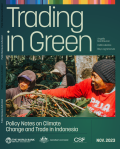This case study examines natural capital depletion in Ecuador from 1971 to 1990—corresponding with an oil boom in the 1970s and economic stagnation in the 1980s. Two natural resource accounting (NRA) methodologies are utilized to measure the economic value of natural capital depletion in the petroleum sector: the Depreciation Method and the User Cost Method.
The study indicates that the value of natural capital depletion derived using the Depreciation Method is $7.8 billion (1987 USD), or 4.3 percent of GDP over the two decades, peaking at 53.8 percent of GDP in 1976. The User Cost Method indicates that the capital element of oil revenues over the two decades is $16.2 billion, or 8.9 percent of GDP over the two decades (1987 USD).
The study also discusses policy implications related to the depletion of Ecuador's oil reserves. This includes policy failures such as the targeting of oil revenues towards current public sector expenditures and non-oil tax revenues lagging behind expenditures. It concludes that until such policy failures are addressed, speeding natural capital depletion is an unwise decision.


